As has become usual, one of these white papers begins with a customer interaction. Almost always it's either a phone call or email, but sometimes it's in person. Anyway, in the process of getting to an answer, it occurs to me others may be interested as well - maybe you!
There are many questions and answers in this one as we go all over the map in terms of servos, mounting, linkages, cost, etc. because I dug through the sent message emails using throttle+servo as search terms and found many, if not all, the conversations related to throttle servos. And I keep adding to it!
Anyway, I hope what follows is of interest and useful, both! Moreover, we'll be using both computer renders and photos to try and emphasize some of the information for how and where to mount a servo, and what not to do regarding throttle linkages.. So let's dive in!

Q. What's the lightest servo you would recommend for throttle use? I would use the DS90DLHV but if 30 grams can be saved with a smaller servo that would be great.
A. While I totally respect the position of 'lighter' because grams add up, unless you don't have the space, or vibration is nil, I urge you to stick to the DS90DLHV. True, unless I needed rapid transit in which case the DS255BLHV is the clear winner. But when transit time is of no concern, then I'd use the DS90 every single time with internal combustion engines *except* due to space concerns. But over weight concerns? Find elsewhere to save is my best advice.
For example, we have four century-class servos, the DS90, DS105, DS100, and DS110 (all effectively outputting 100oz-in) and I totally grok weight savings but reliability trumps all in my book. What about yours? Put another way, what is the mission cost if there's a failure?
Perfect example, our DS105CLHV at <21g is about the same torque-wise as a DS90DLHV at about 61g (a 40g savings), but in terms of ruggedness and ability to resist vibration, it's a whole other story. Simply put, the smaller servo will wear or break whilst the DS90 soldiers on pretty much whenever there is any vibration.
- No vibration? With an engine? Pull the other leg!

Q. The throttle servo on my gasoline-powered Phoenix Spitfire quit on me. So I flew 10 minutes at part throttle until the engine died (so I could dead stick to a landing because the throttle cut wasn't working either). Glad I didn't crash! Oh and if you're wondering, it wasn't a ProModeler servo! Anyway, since I don't want a repeat, which throttle servo in your lineup is best for my gasser? And could I use a micro instead because I mounted the throttle servo on the motor box and it's kind of close to the muffler.
A. The servo quit and throttle cut wasn't working, eh? Wow, it really does pour when it rains! Glad you didn't crash your model. I bought one of this big Spitfires but it's still in the box as time has been short. maybe I'll get to it this winter. As for the servo not being one of ours, sadly, it could have been and it still may have failed. Why? It's because reliability depends on proper installation and the choice of servo pushrod and servo arm. Anyway, to your question if which is the best throttle servo is . . . it depends!
To the question of using a micro servo, in general, standard size servos work better than mini or micro servos because their gears are more massive. Bigger is genuinely better when it comes to throttle servos because a larger servo's larger gears better withstand vibrations. Vibrations, which over time result in excess backlash developing (but no servo regardless of the size is proof against developing excess backlash or slop and or failing because of the potentiometer). This last, the potentiometer failing is what most often kills throttle servos. it's vibration induced pot failure.
Seriously, engine vibration is a big deal. And especially with a single-cylinder gasser more so than multis, which run a lot smoother and thus, are far easier on the servo, linkage, and airframe. Anyway, since you always want to stack the odds in your favor, begin by using a physically largest servo instead of a smaller one.
Also, bear in mind a single-cylinder engine is akin to a paint shaker in terms of vibration compared to a multi-cylinder engine. The singles are much rougher on throttle servos. Bottom line? Bigger is better! And for virtually any model, you don't need an expensive servo for throttle, our DS90DLHV is just fine.

Anyway, I'd bet a milkshake (without seeing the servo or even knowing which brand), is the potentiometer is what failed. This, because it's the usual suspect for dead throttle servos. And note; it's happened to me in the past as well, which is how I developed what I call the best practice for mounting and installing servos for throttle use. Speaking of mounting, please review this article before proceeding.
So what are factors at work when selecting a throttle servo for gasser powered project? Cost is a big one, maybe the principal one for most, but so is performance for some, like 3D and helicopter modelers.
For example, how quickly the throttle servo reacts for a sport model or a scale warbird is not much of an issue. But if you're performing torque rolls, then throttle speed is absolutely an issue to consider. However, for most models, transit speed doesn't matter it means the DS90DLHV is a popular choice because it only costs $30.


So for a sport model, or a warbird like my own paint shaker equipped (DA-85) Mustang, I'm perfectly satisfied with a DS90DLHV for throttle (and another for choke). And I like using a PDRS105 (a seriously heavy duty glass-filled nylon servo arm because being plastic it helps damp engine-induced vibrations). This plastic servo arms is quite massive and is designed to accept a bog-standard 4-40 ball link as offered by DuBro, Sullivan, and others, or M3 hardware (either M3 or 4-40 works). Here are links to both
Selecting any link opens another browser instance in a new tab so you don't lose your place. Anyway, because I've saved up more than one query related to throttle servos, let's move on to the next one!
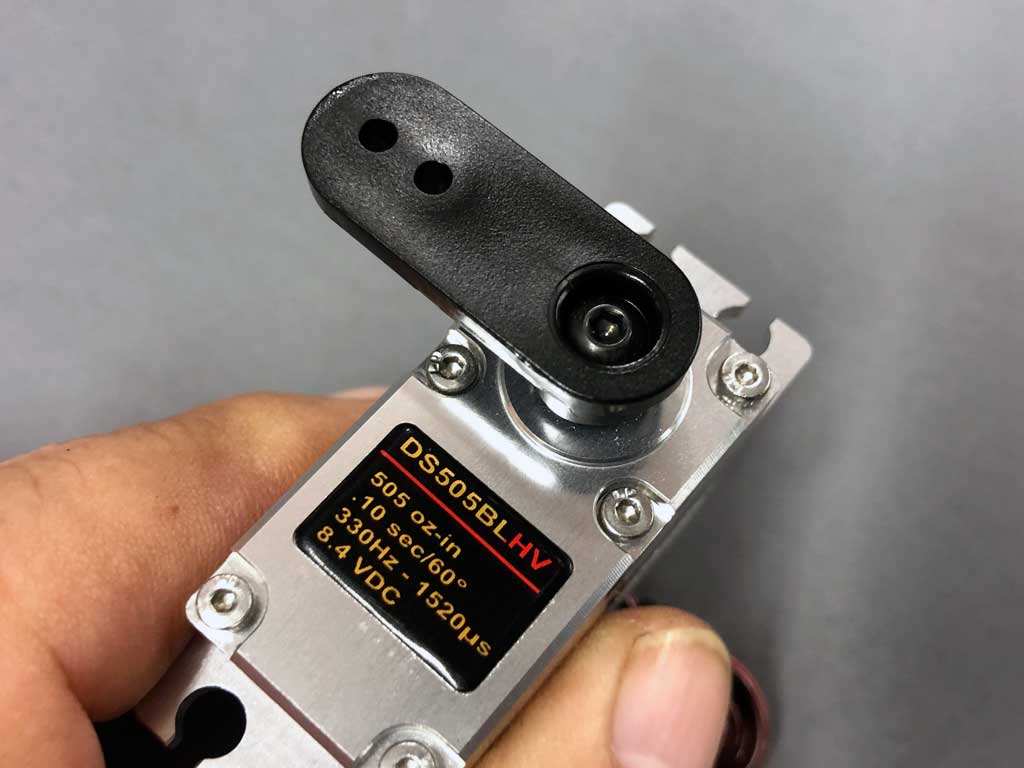
- A gnarly glass-filled nylon arm like this PDRS105 helps resist vibration induced damage

Q. What throttle servo do you recommend for my Extreme Flight 78" Extra powered by a DA35?
A. A good choice for any 3D-type model is going to be one where the transit speed is high because some maneuvers, especially rolling Harriers and torque rolls, require the servo to react very, very quickly. This means you want a really fast servo like the DS255BLHV.

Q. I'm building a 35% CARF 2.6m Extra 330SC and will power it with a DA120. I fly very aggressive 3D maneuvers and went with your recommended DS635/DS845/1155BLHV on the flight controls. I also went with the DS255BLHV on throttle but am having second thoughts. This is my dream model and I don't care what it costs, what servo do you recommend for the throttle when money is no object?
A. Honesty? The DS255BLHV is all the servo you need. However, when your money grows on trees, then without question the most suitable for this purpose is another DS635BLHV like you're using on aileron.
And yes, of course I know you don't need 635oz-in of torque to operate a throttle (but you don't need 255 either because 10oz-in would suffice). So what you're paying for is raw speed. How fast? It's rated at 0.04sec/60° and is actually a hair faster. Hands down, this is our best for purpose. But I still maintain the DS255BLHV is fine for your needs but if you insist, here's a link.

Q. I fly a Zenoah G-26 powered helicopter, what would you recommend in the way of a throttle servo. And please use a plastic servo arm like a PDRS105 offered for 2 bucks.
A. For sport, a DS90DLHV is all you need and for 3D maneuvers, then either the DS255BLHV (or DS635BLHV). The latter for when money is no object - unusual for modelers - but not always, so I mention the DS635 just to cover our bases.

Q. I've got an outrigger tunnel hull with two Zenoah 35cc engines, what do you recommend for throttle servos? I need two.
A. Boats are HARD on throttle servos because you don't have much space for a flexible non-metallic Bowden cable, which is my preference for operating carburetors. But beyond engine vibration (double trouble with twin 35s hammering on the structure), water transmitted shock (through the hull and engine bearers) plays a huge role, too. This is because at 70mph water is hard as concrete.
Honestly, all the factors mentioned above means paying special attention to servo mounting location, pushrod material (plastic is best for this), and using a plastic servo arm. These are all details worth paying close attention (more below). Review this article:
Anyway, a lot of boat guys like the DS90DLHV because they're relatively inexpensive. While slowish at 0.17sec/60° honestly, for a boat (and nearly all warbirds, sport model airplanes, and RC trucks, too), the servo's transit speed is generally a non-issue.
A huge benefit for you is this servo has all-steel gears. This means they're durable as all get out and this is especially important at 70-80mph on water. Belize me, boats are hard on servos and your model has twin 35cc engines blasting away and vibrating like the hammers of hell. Word to the wise, eh?
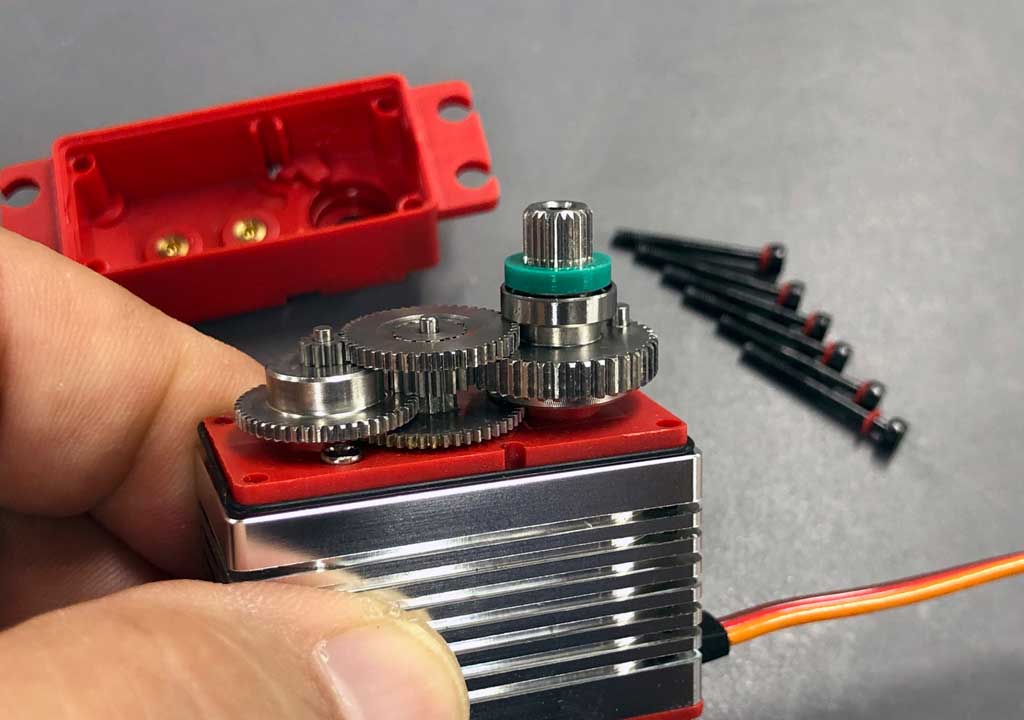
- Note the all-steel gear train of the DS90DLHV, and sealing it up are 13 0rings

Q. I've got a highly modified Losi 5iveT equipped with a 35cc gasoline engine. I've had two throttle servos quit on me and someone recommended ProModeler. What do you suggest in the way of a servo for this application?
A. Big 1/5th scale gas-powered trucks like yours, and others like the 5iveB, Kraken RC's Vesla.5, HPI Baja, MCD's RR5 (plus FT-R and W5) are tough on a throttle servo because of;
- Vibration
- Dust/dirt
- Water
Look, an RC truck, almost by definition, operates in very a dirty environment. That, and guys love playing submarine with them occasionally, so the 13 o-rings of a DS90DLHV servo especially will stand you in good stead, trust me.
Basically, large rigs like these are harder than pretty much anything on planet Earth on throttle servos because unlike a boat where the engine is on hardwood rails, or a model airplane where wood or fiberglass - both serving to attenuate a lot of vibration before it gets to the servo, within a rig the 35cc engine is pounding away on the servo whilst mounted to an alloy frame and thus, is transmitting engine-vibration with virtually zero attenuation because metal is excellent at transmitting vibrations. So the vibrations go directly into the servo through the engine mounts, and into potentiometer through the pushrod (usually short and made of steel). Rigs are a lot like a boat in this regard because there's a VERY short distance between throttle servo and carburetor arm. In a word, gas-powered 1/5th scale gas trucks are 'rough' on servos.
Two factors to think of. First, pushrod material is important, so avoid a 1/16 steel rod like the plague. Opt instead for short section if the inner piece of a Bowden cable to control the throttle because it's more flexible (but because it's so short, plenty stiff for accurate control). Do not under any circumstances ditch the rubber isolation mounts. I know it's popular to hard mount the servos but take my word for it, this is a singularly bad idea. you've been warned! Second, and further to this, and as with boats and model airplanes, I'd strongly advise the heavy duty PDRS105 servo arm because it'll help damp vibration from getting to the potentiometer.
Coming up we'll delve into pushrods (and best practice as it regards throttle pushrods, specifically).

Throttle servo linkages
First, it's important to understand the servo doesn't know (or care) what use you're making of it. E.g. whether it's function is controlling the throttle, elevator, or rudder - it simply doesn't matter. Or whether it's within a boat, airplane, or model truck - again it doesn't 'know' anything about that.
Does this mean you can use a mini instead of a standard size servo? Yes, absolutely. The real question is . . . should you?
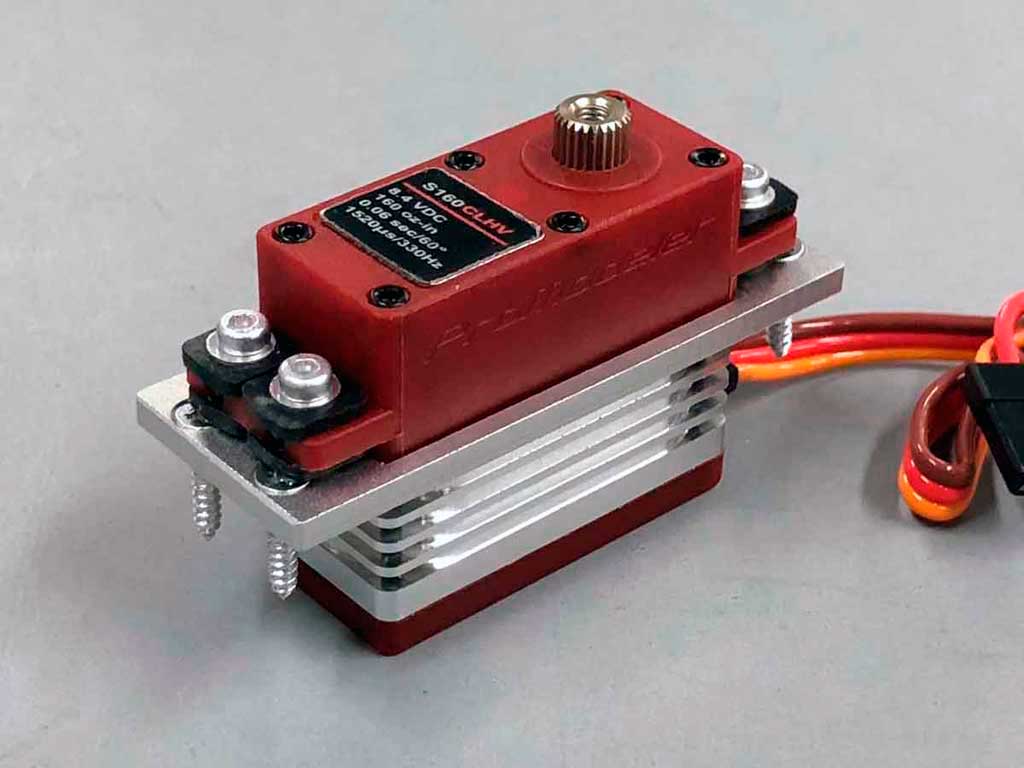
- A mini-class servo mounted to a PDRSS2M mount adapter

The answer to whether you should use a mini for a throttle servo is - it depends. First, if there's no room then it's Hobson's choice, right? But we always recommend using the largest that will physically fit because this means bigger gears and more servo mass (both useful for various reasons to do with damping vibration).
Second, and here's the rub with a servo (any servo, ours, or another manufacturer's) vibration is tough on them. Tough on the gears (accelerated wear) and tough on potentiometers (early failure). Meanwhile, and for reasons unknown (but probably because it's cheaper to mount it far from the engine), there is a fondness amongst giant scale aircraft designers for placing the servo directly on the engine box, or immediately behind the firewall.
This is very bad because it means connecting to the carburetor requires a short straight linkage rod as if it were mounted in a boat/helicopter/truck model. And it's bad for more than one reason. Like it's very hot and it's subject to high levels of vibration. Unfortunately, this is how RC truck/heli/boat guys are forced to mount the servo because there's no room to relocate it further away from the engine. But airplane guys? You can always relocate it to the rear (and at the CG) within the wing opening a few feet away from the engine. This is much better.
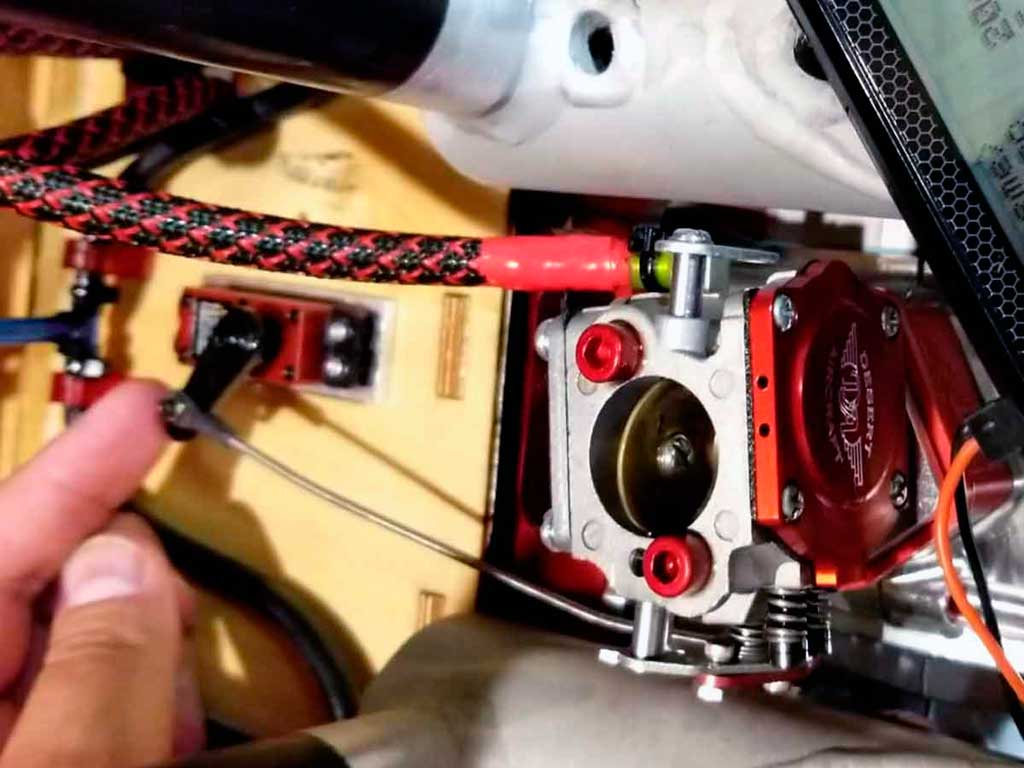
- This is the worst possible connection . . . a direct steel pushrod and metal servo arm!
The above photo shows the worst connection you can make between servo and carburetor, with a short steel pushrod. And it's a bad idea on multiple fronts because in this instance, he's using an aluminum alloy servo arm, also! Mounting the servo on the engine box places it directly on the highest vibration surface of the whole aircraft and near the hot engine/muffler. This is tempting fate!
While truck and boat designers have no choice, the why for this with regard to model airplanes involves model designers and their foibles, which are above my pay grade. However, 'if' I had my druthers I'd never mount a servo on an engine box. Not ever! In fact, with my gassers, I don't ever mount it within two feet of the engine! That, and I run a non-metallic Bowden cable from near the CG (2-3' away) where I mount the servo to operate the carburetor arm. Specifically? I favor the Sullivan brand Gold-N-Rod product.
Available in increasing stiffness ranging from red, blue, and black, I use Sullivan's red 100% of the time. Why? Simple, because it helps absorb engine vibrations before they get to the vulnerable bits of the servo, the potentiometer and the gears. This photo shows an excellent use of a Sullivan Gold_N-Rod for throttle pushrod.
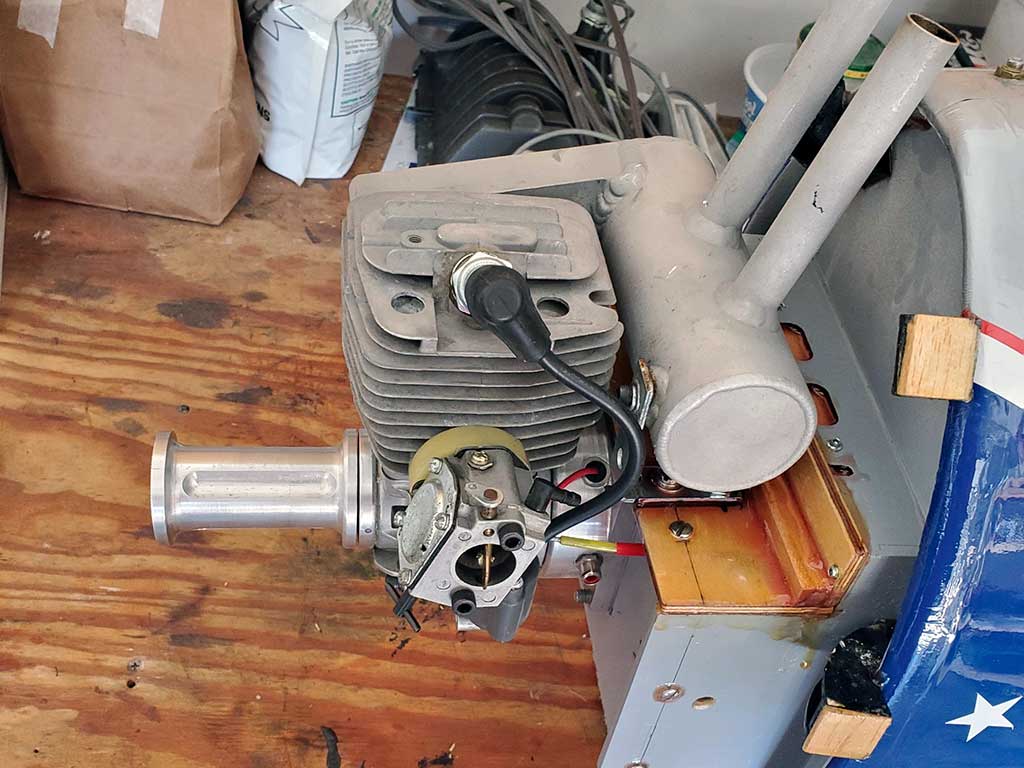
- We recommend using Sullivan's Gold-N-Rod, a Bowden cable setup, for throttle installations

Reason for going to these extreme for the pushrod installation is to do with attenuating vibration when you don't have mass and distance to help. What's being hurt by a steel pushrod is the potentiometer. What makes pots subject to vibration damage is due to fundamental servo design. Let's briefly go into that by showing you where it's located.

Servo potentiometers
Below is a render of the cross section of a typical ProModeler servo. And please note; this isn't an unusual configuration for the potentiometer placement of any servo brand/model. In fact, it's probably what you'll find within every other servo on the market!
Do you see how it sits directly below the output gear, which is made of metal? If you connect something vibrating like mad to the output gear, the vibrations feed directly into the pot and throughout the gear train. Worse, there's absolutely nothing we can do about it as a practical matter on the servo design standpoint other than soft mount the servo and use a a connection between carburetor and servo that absorbs/dampens vibration as much as possible.
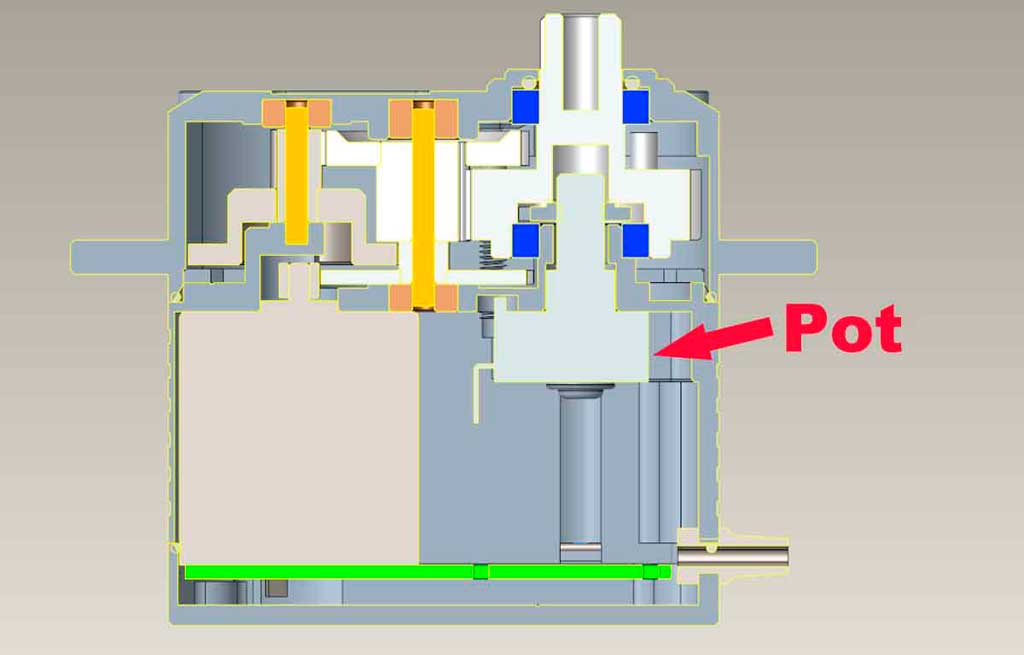
- The potentiometer directly engages the output gear - no isolation at all.

Anyway, the pot sits directly below the output gear and is connected mechanically to the output shaft on which we install the servo arm. So whenever a modeler uses a steel pushrod for the throttle - the engine vibrations are being transmitted directly into the potentiometer and the gears. For the pot especially this is bad. It means the pot's lifespan is being degraded much faster than would otherwise be the case. How much? From thousands of flights/runs to dozens or low hundreds. And sometimes just a few before failure! Modelers using a steel pushrod are acting almost as if they wanted to destroy the function of the servo - not kidding!
Basically, the pushrod picks up engine vibrations and feeds these destructive vibrations directly into the potentiometer itself. Worse, steel does absolutely 'nothing' to attenuate the vibration. Frankly, it's no wonder the throttle servos may quit working in short order with gassers. And it's entirely to do with the potentiometer being eaten alive by the engine vibration!
Fortunately, if your servo dies, it's probably just the potentiometer and we offer replacement potentiometers. Moreover, they're mostly easy to replace (three solder joints) so it's a DIY for a lot of modelers. The upshot is; unlike other brands, because we'll sell you just the pot you can fix it yourself instead of being forced to send it in for repair. The other guys? It pays to ask about this ahead of time, capice?
This begs the question, why not use a Hall Effect sensor instead of a potentiometer? Good question. Reason has to do with how these fail versus how a pot fails. Sudden or slowly. Learn more with this article.
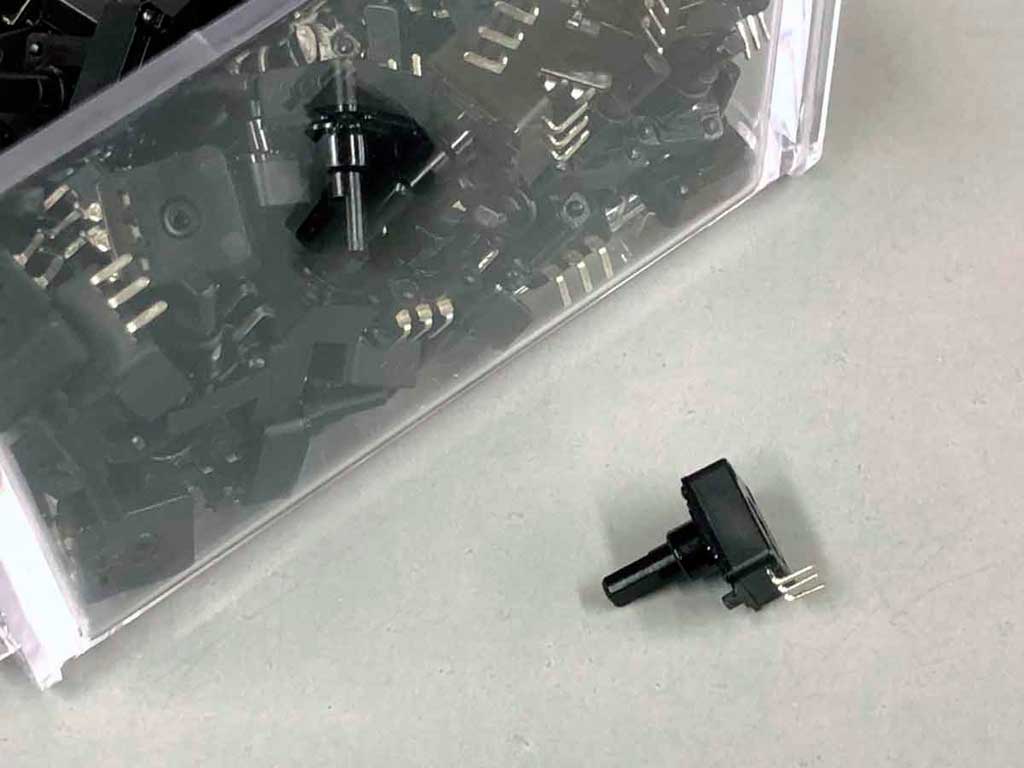
- Killing a potentiometer isn't the end of the world - it's an easy fix.

Q. Is there a solution for dealing with engine vibration?
A. Well, yes, there is. In a nutshell, it involves three factors;
- use a non-metallic pushrod, and
- relocate the servo from the engine box, and
- use a plastic servo arm.
When modelers are forced to mount the servo on, or near the engine box (or when used in a boat or truck) then using a very short pushrod made of plastic instead of steel is the next best thing to relocating the servo. That, plus a polymer servo arm to help further damp vibration.
So for car/boat/helicopter guys, as with aircraft modelers, we suggest switching from a short steel pushrod to just the inner section of a red Gold-N-Rod, instead. Why? It's because within a mere 2-6" length the usually flexible cable is actually plenty stiff enough to operate a carburetor's butterfly valve. And use plastic links instead of metal. And we also prefer using a polymer servo arm like the PDRS105 instead of an aluminum servo arm, for the same reason. And I'm not yapping about this to sell a $2 arm and promote Sullivan but because all this plastic attenuates the vibration better.
Anyway, Sullivan sell these Bowden cable set ups with red, blue, and black sheaths (most flexible to least). In my experience, the blue sheath stuff is OK for model airplanes (the black is designed for 4-40 hardware and is far too stiff), but the lightweight red/yellow is my overall favorite. And while maybe we should, we don't sell Sullivan or DuBro pushrod hardware, sorry.

Q. I'm trying to decide between a DS90DLHV and a DS255BLHV for the throttle servo of my 96" F4U Corsair. I know you say don't really need the speed of the DS255BLHV but is this one 'better' than the DS90DLHV? I figure it is since it costs twice as much, but why is this?
A. 'Better' comes down to servo's motor and its construction, e.g. torque if you need more and all-alloy if this will matter for durability and impact resistance. In honest truth, there's really no 'better' in the ProModeler line up. Not whether a servo costs $30 or more than $300. Every single one is our best . . . no kidding.
Thus because the DS255BLHV (and its sister servo, the DS415BLHV) have steel gears like the DL-series has all-steel gears and BLO1, BLS1, and BLS2 servos, as well, there's no 'better' in terms of gears in the standard line up regardless of cost. What may possibly makes one servo better than an other is case construction, transit speed or torque rating, but as far as the servo goes, we litterlay make every single one pick of the litter against our competitors.
We feel this makes ProModeler servos better overall, but one is not 'better' than the other in the classical sense. The difference in a performance almost entirely comes down to the servo's motor. To learn more about this, I recommend you review this material . . .
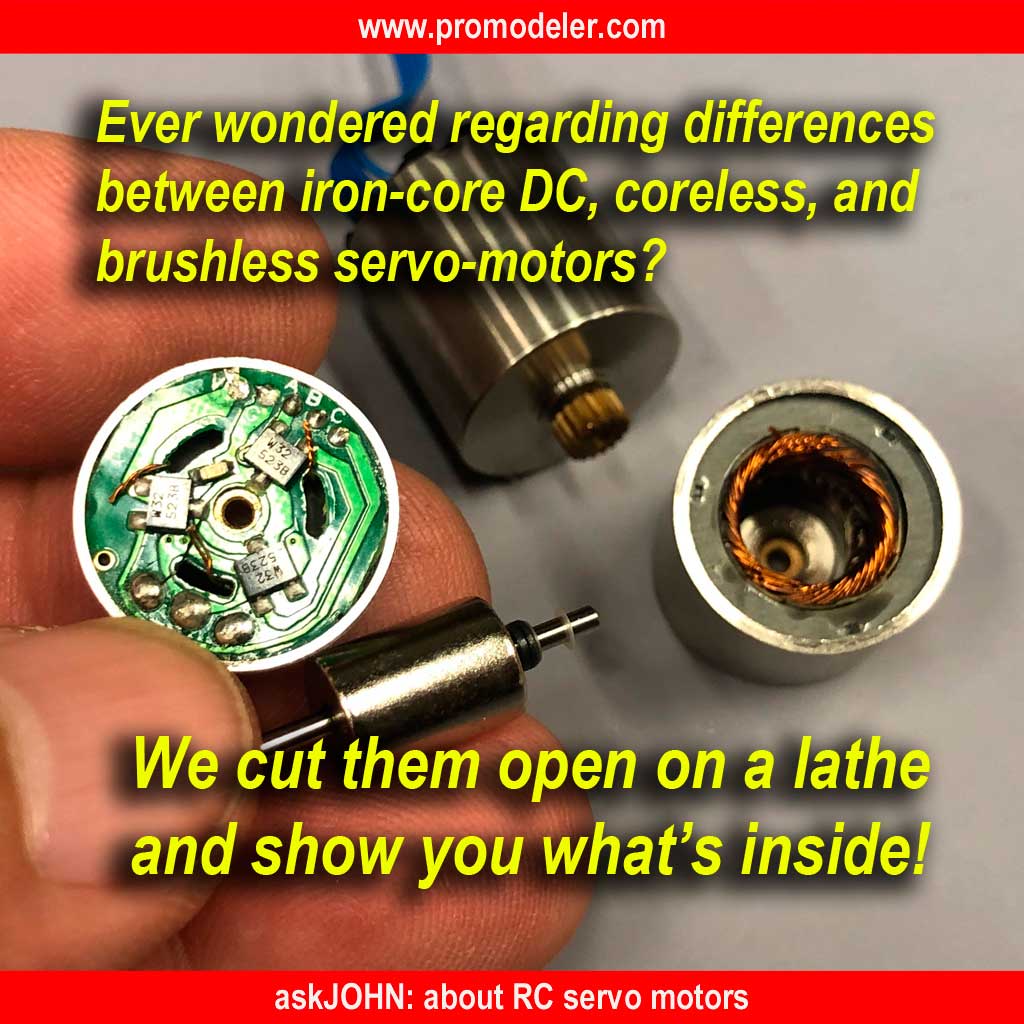
. . . and as usual, whenever you click one of these links, the page conveniently opens in a new browser tab so you don't lose your place.

Q. I've read where you recommend mounting servos on the center of gravity, why is this?
A. Yes, I mention doing this frequently and in part it's to do with the dumbbell effect, or moment of inertia (more simply, just 'moment'). There are several added benefits of mounting the servo on the CG and they're to do with attenuating vibration as well as the effects of interference from the ignition system when it's failing.
- With the servo at the CG, the model's structure forward of the servo helps attenuate (dampen) some of the vibration from the engine.
- Not having a steel pushrod eliminates the worst of the vibration from being transmitted into the pot (plus the possibility of ignition noise making its way into the servo and driving it crazy).
- A plastic servo arms attenuates vibration better than metal.
- Specifically to your question; the model tumbles about the CG more easily because the mass of the servo is right on the CG (remember the dumbbell effect). No, it's not much with a 2-oz servo but every little bit helps. Also, remember, the dumbbell effect, for example using a bar in the gym with two 20 pound weights at the ends, is harder to spin like a majorette twirling a baton than if you move the weights inward to the center of the bar. Though, and in all honesty, regarding number four, only the best pilots can possibly tell the difference involving moving a few ounces to the CG - but it's our view every bit helps.
- And finally, perhaps most importantly with gassers using ignition modules, when the shielding begins to fail the module becomes a transmitter broadcasting noise on all frequencies. About the only thing that may save your model's receiver form being swamped by spurious signal is physical distance between the module and the receiver. Moreover, when a servo is on the motor box, then it and the extension act like an antenna for the receiver to pick up the signal. Yup, the extension is the highway across the castle moat's like a lowered drawbridge, right into the keep for enemy troops.
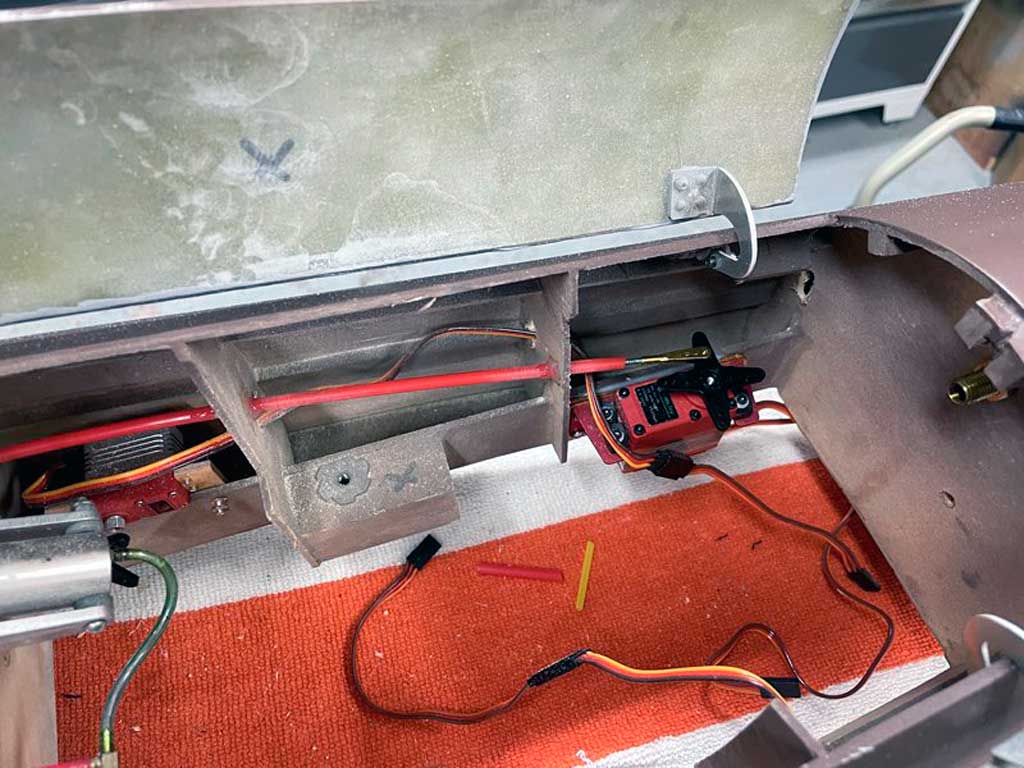
- A savvy modeler mounts things near the CG when possible, even servos

Q. I know you say don't do it but I 'want' to mount the throttle servo on the motor box. Is there anything I can do to make this easier on the throttle servo?
A. You know I'm going to say please reconsider - but - if for whatever reason you can't/won't then our recommendation is - at a minimum - to ditch the short 1/16" steel pushrod. Instead, resort to using a short section of the inner part of a Sullivan Gold-N-Rod. At less than 6" it's plenty stiff to do the job. And use plastic links like in this photo.
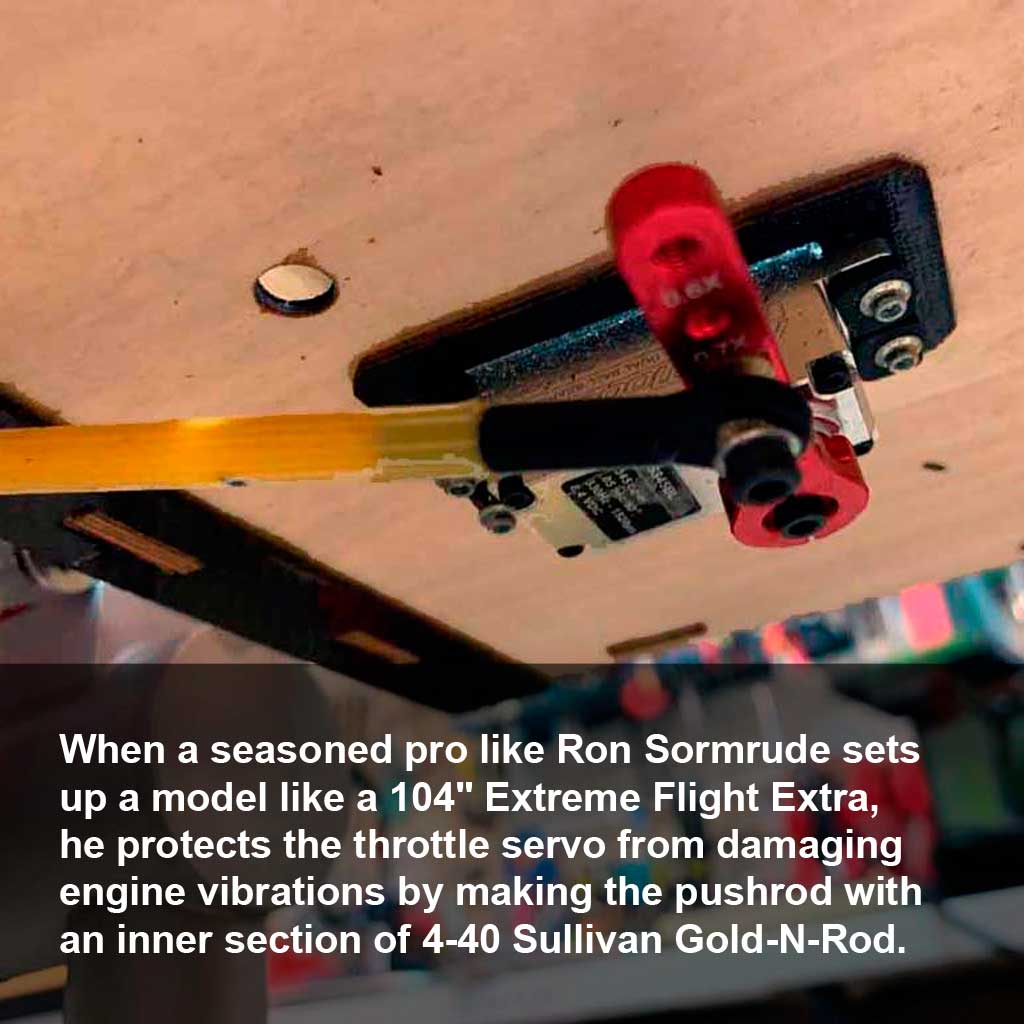
- Best practice involves a flexible piece of Sullivan Gold-N-Rod inner.

Why a plastic? Principally because the plastic helps attenuate vibration. Maybe enough to 'maybe' let the servo live. Also, please consider using a plastic servo arm like the PDRS105 as well because it's bulk helps dampen vibration also.
However, the biggie in all this is the plastic throttle pushrod vs. 1/16' steel pushrod. And we know it looks trick, and we appreciate your buying our fancy aluminum throttle arm, but the less costly plastic arm is a FAR better choice, in our opinion.
And yes, we know opinions are like belly buttons because everybody has one but remember, we are the folks producing your servos so this should count for more than some anonymous internet expert's opinion, capice?

Closing thoughts
Some internet expert always brings up expansion/contraction of a Gold-N-Rod as a reason to not use it. As if steel doesn't expand and contract also, duh! Anyway, this is totally a non-issue, believe me. Remember, when dealing with a paint shaker of a gasser engine, the goal is to attenuate vibration so your servo will live a longer life because being stuck in the air at part or full throttle and dealing with a dead throttle servo sucks! The slight change in length between summer and winter is easily within the use of a trim tab to correct.
Last thing
Gasoline ignition engines rely on either a magneto for ignition or a standalone battery-powered ignition module. I'll close with this, I wish I could persuade modelers to never locate a throttle servo within two feet of either of these. Why?
It's because the servo lead is the drawbridge over the moat for ignition noise making it into the castle (e.g. into the receiver). No, not when everything is working as designed, but when things go pear shape and you've got stray RF making racket. That's when, quite honestly, there's nothing better than distance from the source.
Toward that goal a) I try hard to achieve two feet between receiver and any control avionics wiring, and b) I 'always' use a non-metallic Bowden cable to control throttle (and choke if so equipped).
I've mentioned it more than once (and we don't sell them so I don't have a dog in the hunt) but I favor the Sullivan brand Gold-N-Rod product (preferring the red, which is the lightest made for purpose). Anyway, I never 'ever' use a 1/16 metal pushrod like so many favor. This, because the potentiometer lives directly beneath the splined output shaft and the vibration is akin to touching the shaft with a vibrating marking tool (electric scribe).
After all, the servo has a hard enough life dealing with engine vibrations as it is, why make the pot deal with anything more? My first gasoline engine was a magneto ignition Quadra 35 a Canadian fellow by the name of Dario Brisighella introduced me (and many thousands of modelers) to almost 40 years ago.
In the years since, I've operated many, many gassers and I'm one of the guys fellows turn to when they have engine problems because I seem to have an affinity with them. My point? When everything is working right, they're a lovely motive source of economical power.
However, it's when things go to Hell that you'll come to appreciate what I'm telling you about mounting your throttle servo as far from the ignition source as is practicable. And that this coincides with it being as far from the source of heat and vibration is a lovely happenstance.
Let me repeat . . . I prefer mounting a throttle servo near the CG, with about two feet of distance between the paint shaker up front (and the ignition). Trust me and consider these words to live by from a very experienced old hand.
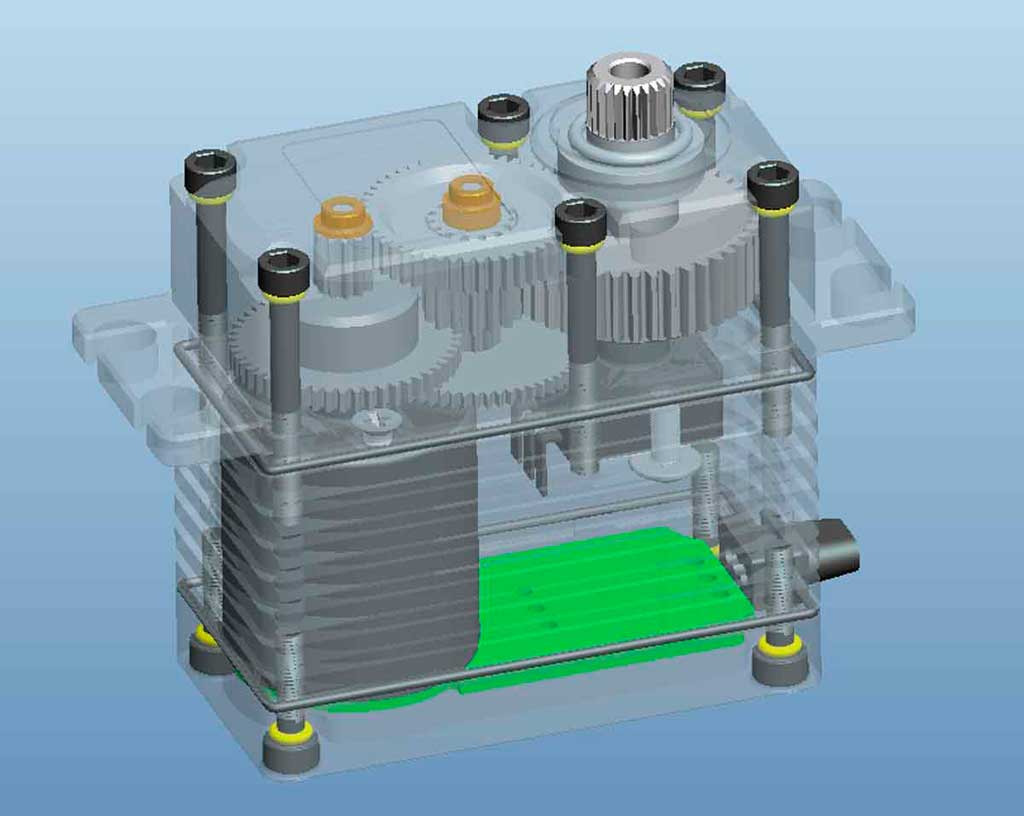
- SolidWorks render of DS255BLHV showing component layout